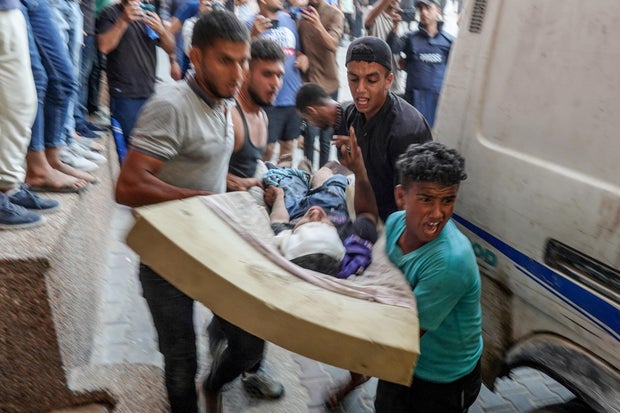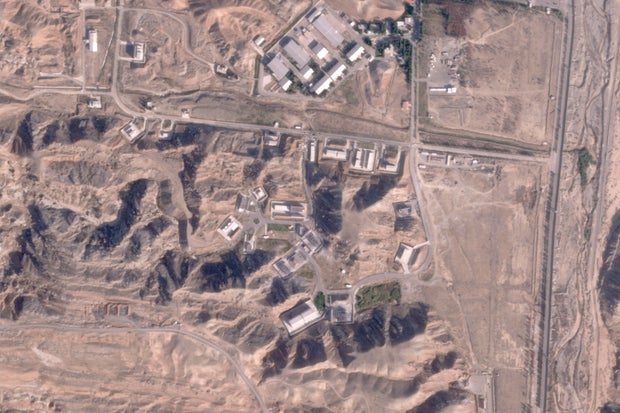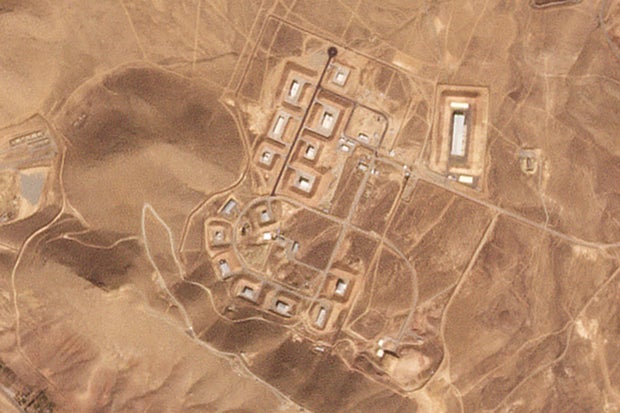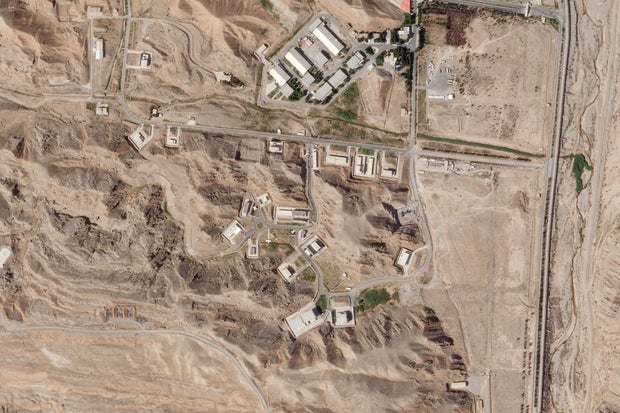CBS News
Hamas says Israel’s deadly strike on a Gaza school could put cease-fire talks back to “square one”

Tel Aviv — A surge of hope for a breakthrough in Israel-Hamas cease-fire talks drew CIA Director William Burns back to the Middle East this week, but the hopes have been tempered by a blistering Israeli airstrike on a school sheltering displaced Palestinians in southern Gaza. The attack killed at least 29 people at the Al Awda school in Khan Younis, according to an official at the nearby al-Nasser Hospital.
In a statement, the Israel Defense Forces said it used a “precise munition” in the strike on the school to kill a militant who took part in Hamas’ Oct. 7 terrorist attacks, which killed almost 1,200 people.
The IDF said it was reviewing the incident, but it has always blamed Hamas for all of the deaths in the war, accusing the group of using Palestinian civilians as human shields and basing weapons and fighters in schools, hospitals and homes.
BASHAR TALEB/AFP/Getty
The IDF has also launched a new assault further north, in Gaza City, calling for yet another evacuation of Palestinian civilians. Images posted online Wednesday showed people holding fliers dropped by the military in the area, urging people to leave.
Hundreds of thousands of people trapped in Gaza, a narrow strip of land sandwiched between Israel and the Mediterranean Sea, have fled from the fighting four or five times already.
The United Nations called the forced exodus “dangerously chaotic” — with doctors and nurses at two hospitals rushing to move their patients.
The IDF said medical facilities did not need to evacuate, but its previous raids at other hospitals in Gaza have left medical staff fearful.
Hamas said the new assault could “reset the negotiation process to square one,” despite Israeli Prime Minister Benjamin Netanyahu agreeing to send a delegation to restart the talks.
Netanyahu agreed to send the Israeli delegation back to the talks after Hamas replied to the latest draft cease-fire proposal with some requested changes, but both sides have remained at odds on key points of a staged truce process. One of the biggest obstacles has been Netanyahu’s insistence that any cease-fire agreement leaves his military the option to resume operations against Hamas.
Alon Pinkas, a former advisor to four Israeli foreign ministers and an outspoken critic of Netanyahu, told CBS News on Wednesday that he believes — as do many Israelis — that the country’s leader doesn’t really want a cease-fire.
Asked if Netanyahu, by agreeing to continue with the truce talks, was just throwing a bone to his backers in Washington to keep the pressure off, Pinkas said the Israeli leader’s actions were even more disingenuous than that.
“He’s just taking them for a ride,” he said. “He’s [Netanyahu] been doing so for the better part of the last nine months, and he’s been doing so with impunity and immunity.”
The Israeli leader has accused Hamas of blocking progress in the talks, suggesting the group isn’t serious about the negotiations as it has also continued its military operations against Israel during multiple rounds of discussions.
The White House has consistently backed Israel’s right to defend itself against Hamas and, with few exceptions, has and never halted the supply of U.S. weapons to the country. But Mr. Biden and his subordinates have also heaped pressure on Netanyahu to allow more humanitarian aid into Gaza and limit the number of civilian casualties in a war that medical officials in the Hamas-run enclave say has killed more than 38,200 Palestinians.
President Biden announced a project in March to boost the flow of aid into the territory — a floating pier built by the U.S. military on Gaza’s coast at a cost of more than $230 million.
The pier project, always touted by U.S. officials as an additive measure and not a solution to the dire humanitarian crisis in Gaza, has been plagued by logistical challenges, mostly weather related, and it has never managed to facilitate a significant flow of aid materials.
After being knocked out of service again by rough seas, operations on the pier were to be reestablished this week — but then the structure could be permanently dismantled. The removal could come as soon as next week, but no final decision has been made according to U.S. military officials.
CBS News
Satellite images show damage from Israeli attack at 2 secretive Iranian military bases

An Israeli attack on Iran damaged facilities at a secretive military base southeast of the Iranian capital that experts in the past have linked to Tehran’s onetime nuclear weapons program and at another base tied to its ballistic missile program, satellite photos analyzed Sunday by The Associated Press show.
Some of the buildings damaged sat in Iran’s Parchin military base, where the International Atomic Energy Agency suspects Iran in the past conducted tests of high explosives that could trigger a nuclear weapon. Iran long has insisted its nuclear program is peaceful, though the IAEA, Western intelligence agencies and others say Tehran had an active weapons program up until 2003.
The other damage could be seen at the nearby Khojir military base, which analysts believe hides an underground tunnel system and missile production sites.
Israel launched a series of strikes on Iranian military facilities in retaliation for the barrage of ballistic missiles the Islamic republic fired on Israel earlier this month.
Planet Labs PBC / AP
Iran’s military has not acknowledged damage at either Khojir or Parchin from Israel’s attack early Saturday, though it has said the assault killed four Iranian soldiers working in the country’s air defense systems.
Iran’s mission to the United Nations did not immediately respond to a request for comment, nor did the Israeli military.
However, Iranian Supreme Leader Ayatollah Ali Khamenei on Sunday told an audience that the Israeli attack “should not be exaggerated nor downplayed,” while stopping short of calling for an immediate retaliatory strike. Israeli Prime Minister Benjamin Netanyahu said Sunday that the strikes “severely harmed” Iran and achieved all of Israel’s goals.
“The air force struck throughout Iran. We severely harmed Iran’s defense capabilities and its ability to produce missiles that are aimed toward us,” Netanyahu said in his first public comments on the strikes.
It remains unclear how many sites in total were targeted in the Israeli attack. There have been no images of damage so far released by Iran’s military.
Planet Labs PBC / AP
Iranian officials have identified affected areas as being in Ilam, Khuzestan and Tehran provinces. Burned fields could be seen in satellite images from Planet Labs PBC around Iran’s Tange Bijar natural gas production site in Ilam province on Saturday, though it wasn’t immediately clear if it was related to the attack. Ilam province sits on the Iran-Iraq border in western Iran.
The most telling damage could be seen in Planet Labs images of Parchin, some 40 kilometers (25 miles) southeast of downtown Tehran near the Mamalu Dam. There, one structure appeared to be totally destroyed while others looked damaged in the attack.
At Khojir, some 20 kilometers (12 miles) away from downtown Tehran, damage could be seen on at least two structures in satellite images.
Analysts including Decker Eveleth at the Virginia-based think tank CNA, Joe Truzman at the Washington-based Foundation for Defense of Democracies and former United Nations weapon inspector David Albright, as well as other open-source experts, first identified the damage to the bases. The locations of the two bases correspond to videos obtained by the AP showing Iranian air defense systems firing in the vicinity early Saturday.
At Parchin, Albright’s Institute for Science and International Security identified the destroyed building against a mountainside as “Taleghan 2.” It said an archive of Iranian nuclear data earlier seized by Israel identified the building as housing “a smaller, elongated high explosive chamber and a flash X-ray system to examine small-scale high explosive tests.”
“Such tests may have included high explosives compressing a core of natural uranium, simulating the initiation of a nuclear explosive,” a 2018 report by the institute says.
Planet Labs PBC / AP
In a message posted to the social platform X early Sunday, the institute added: “It is not certain whether Iran used uranium at ‘Taleghan 2,’ but it is possible it studied the compression of natural uranium hemispheres, which would explain its hasty and secretive renovation efforts following the IAEA’s request to access Parchin in 2011.”
It’s unclear what, if any, equipment would have been inside of the “Taleghan 2” building early Saturday. There were no Israeli strikes on Iran’s oil industry, nor its nuclear enrichment sites or its nuclear power plant at Bushehr during the assault.
Rafael Mariano Grossi, who leads the IAEA, confirmed that on X, saying “Iran’s nuclear facilities have not been impacted.”
“Inspectors are safe and continue their vital work,” he added. “I call for prudence and restraint from actions that could jeopardize the safety & security of nuclear & other radioactive materials.”
Other buildings destroyed at Khojir and Parchin likely included a warehouse and other buildings where Iran used industrial mixers to create the solid fuel needed for its extensive ballistic missile arsenal, Eveleth said.
In a statement issued immediately after the attack Saturday, the Israeli military said it targeted “missile manufacturing facilities used to produce the missiles that Iran fired at the state of Israel over the last year.”
Destroying such sites could greatly disrupt Iran’s ability to manufacture new ballistic missiles to replenish its arsenal after the two attacks on Israel. Iran’s paramilitary Revolutionary Guard, which oversees the country’s ballistic missile program, has been silent since Saturday’s attack.
Iran’s overall ballistic missile arsenal, which includes shorter-range missiles unable to reach Israel, was estimated to be “over 3,000” by Gen. Kenneth McKenzie, then-commander of the U.S. military’s Central Command, in testimony to the U.S. Senate in 2022. In the time since, Iran has fired hundreds of missiles in a series of attacks.
There have been no videos or photos posted to social media of missile parts or damage in civilian neighborhoods following the recent attack – suggesting that the Israeli strikes were far more accurate than Iran’s ballistic missile barrages targeting Israel in April and October. Israel relied on aircraft-fired missiles during its attack.
However, one factory appeared to have been hit in Shamsabad Industrial City, just south of Tehran near Imam Khomeini International Airport, the country’s main gateway to the outside world. Online videos of the damaged building corresponded to an address for a firm known as TIECO, which advertises itself as building advanced machinery used in Iran’s oil and gas industry.
Officials at TIECO requested the AP write the company a letter before responding to questions. The firm did not immediately reply to a letter sent to it.
CBS News
Here Comes the Sun: Will Ferrell, Harper Steele and more

Watch CBS News
Be the first to know
Get browser notifications for breaking news, live events, and exclusive reporting.
CBS News
The Strange Shooting of Alex Pennig

Watch CBS News
Be the first to know
Get browser notifications for breaking news, live events, and exclusive reporting.











